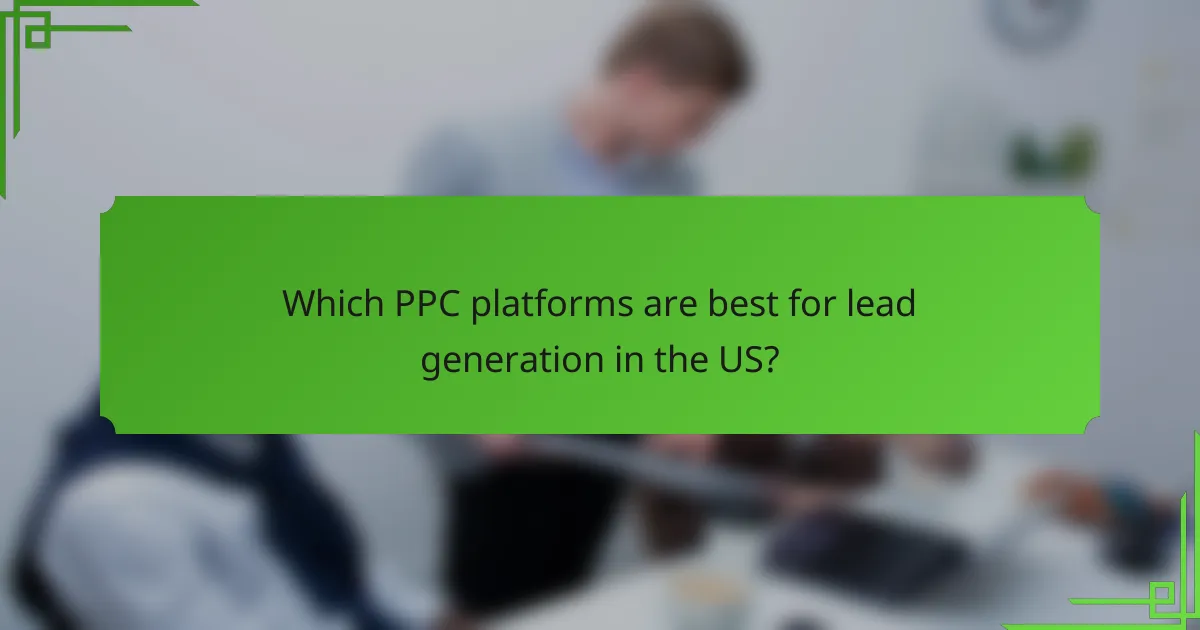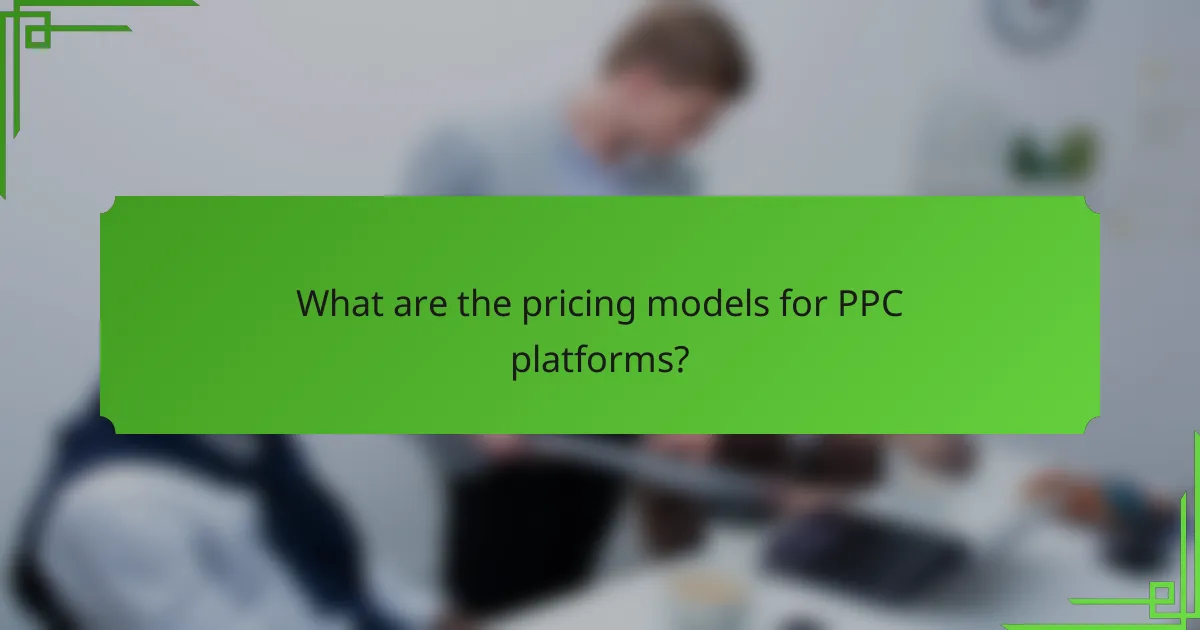Pay-per-click (PPC) advertising is a powerful tool for businesses looking to generate leads and drive traffic. Selecting the right PPC platform is essential, as each offers distinct features and targeting options that cater to different audiences and objectives. By focusing on key elements such as ad targeting, budget management, and analytics, businesses can optimize their campaigns for maximum return on investment.

Which PPC platforms are best for lead generation in the US?
The best PPC platforms for lead generation in the US include Google Ads, Bing Ads, Facebook Ads, LinkedIn Ads, and Amazon Advertising. Each platform offers unique features and targeting options that can effectively reach potential customers based on their online behavior and demographics.
Google Ads
Google Ads is a leading platform for lead generation, leveraging the vast reach of Google’s search engine. Advertisers can create text, display, and video ads, targeting specific keywords that potential customers are searching for.
Consider using Google Ads for its robust analytics and tracking capabilities, which allow you to measure performance and optimize campaigns in real-time. A common strategy is to focus on high-intent keywords, which can lead to better conversion rates.
Bing Ads
Bing Ads, now known as Microsoft Advertising, is often overlooked but can be a cost-effective alternative to Google Ads. It typically has lower competition and can yield a higher return on investment for certain demographics.
When using Bing Ads, take advantage of its integration with LinkedIn for targeting professionals. This can be particularly useful for B2B lead generation, where you can reach decision-makers more effectively.
Facebook Ads
Facebook Ads excels in targeting specific audiences based on interests, behaviors, and demographics. This platform is ideal for businesses looking to engage users visually through images and videos.
Utilize Facebook’s lead generation ads, which allow users to submit their information directly within the platform. This can streamline the process and increase conversion rates, especially for mobile users.
LinkedIn Ads
LinkedIn Ads is tailored for B2B lead generation, making it a prime choice for companies targeting professionals and businesses. The platform allows for precise targeting based on job title, industry, and company size.
Consider using Sponsored Content and InMail campaigns to directly engage with your target audience. These formats can help build relationships and generate high-quality leads in a professional context.
Amazon Advertising
Amazon Advertising is particularly effective for e-commerce businesses looking to generate leads through product listings. It allows advertisers to promote their products directly on Amazon’s platform, reaching consumers at the point of purchase.
Utilize Sponsored Products and Sponsored Brands to increase visibility and drive traffic to your listings. This approach can be beneficial for capturing leads from users actively searching for products similar to yours.

What features should I look for in PPC platforms?
When selecting PPC platforms, focus on features that enhance ad targeting, budget management, analytics, and integration capabilities. These elements are crucial for optimizing campaigns and maximizing return on investment.
Ad targeting options
Ad targeting options determine how effectively your ads reach the intended audience. Look for platforms that offer demographic targeting, geographic targeting, and behavioral targeting to refine your audience selection. For instance, platforms like Google Ads allow you to target users based on their search history and interests.
Consider the flexibility of targeting options as well. Some platforms provide advanced features such as retargeting and lookalike audiences, which can significantly improve conversion rates. Ensure the platform supports A/B testing to evaluate the effectiveness of different targeting strategies.
Budget management tools
Effective budget management tools are essential for controlling ad spend and maximizing ROI. Look for platforms that offer features like daily budget caps, bid adjustments, and automated bidding strategies. These tools help you allocate your budget efficiently across various campaigns and ad groups.
Additionally, consider platforms that provide real-time budget tracking and alerts for overspending. This can help you stay within your financial limits and adjust your strategies promptly. A good PPC platform should allow you to set specific goals, such as cost-per-acquisition (CPA) targets, to guide your budget decisions.
Analytics and reporting capabilities
Robust analytics and reporting capabilities are vital for measuring campaign performance. Choose platforms that offer comprehensive dashboards with key performance indicators (KPIs) such as click-through rates (CTR), conversion rates, and return on ad spend (ROAS). These metrics provide insights into how well your ads are performing.
Look for customizable reporting options that allow you to generate reports based on specific time frames or campaigns. This flexibility can help you identify trends and make data-driven decisions. Integration with third-party analytics tools can further enhance your ability to track and analyze performance.
Integration with CRM systems
Integration with Customer Relationship Management (CRM) systems is crucial for aligning your PPC efforts with overall marketing strategies. Platforms that seamlessly connect with popular CRM tools can help you track leads and conversions more effectively. This integration allows for better management of customer data and insights.
Evaluate how well the PPC platform integrates with your existing CRM. A strong integration can facilitate automated data sharing, enabling you to nurture leads based on their interactions with your ads. This can enhance your targeting and improve customer engagement over time.

How do I choose the right PPC platform for my business?
Choosing the right PPC platform involves understanding your business needs, target audience, and budget. A well-selected platform can enhance your advertising effectiveness and return on investment.
Define target audience
Identifying your target audience is crucial for selecting a PPC platform that aligns with their online behavior. Consider demographics such as age, gender, location, and interests to ensure your ads reach the right people.
For instance, if your audience is primarily young adults, platforms like Instagram or TikTok may be more effective than traditional search engines. Utilize audience insights and analytics tools to refine your understanding.
Assess budget constraints
Your budget significantly influences which PPC platform is suitable for your business. Determine how much you can allocate for advertising, keeping in mind that different platforms have varying costs per click (CPC) and overall spend requirements.
For example, Google Ads may require a higher initial investment compared to platforms like Facebook Ads. Establish a budget range and be prepared to adjust based on performance metrics and campaign goals.
Evaluate platform features
Different PPC platforms offer unique features that can impact your advertising strategy. Assess tools such as ad targeting options, analytics capabilities, and integration with other marketing channels.
For example, Google Ads provides extensive keyword targeting and remarketing options, while Facebook Ads excels in demographic and interest-based targeting. Choose a platform that offers features that align with your campaign objectives.
Consider industry relevance
Industry relevance is a key factor in selecting a PPC platform. Some platforms cater better to specific industries or business types, influencing ad performance and reach.
For instance, B2B companies may find LinkedIn Ads more effective, while e-commerce businesses might benefit from Google Shopping Ads. Research industry benchmarks and case studies to guide your decision.

What are the pricing models for PPC platforms?
PPC platforms typically use various pricing models to determine how advertisers are charged for their campaigns. The most common models include cost-per-click (CPC) and cost-per-impression (CPM), each with distinct mechanisms and considerations for advertisers.
Cost-per-click (CPC)
Cost-per-click (CPC) is a pricing model where advertisers pay each time a user clicks on their ad. This model is beneficial for campaigns focused on driving traffic to a website, as it directly correlates costs with user engagement.
When using CPC, advertisers should set a maximum bid for how much they are willing to pay per click. Bids can vary widely, often ranging from a few cents to several dollars, depending on the competitiveness of the keywords. It’s crucial to monitor the return on investment (ROI) to ensure that the cost per click aligns with the value generated from conversions.
Cost-per-impression (CPM)
Cost-per-impression (CPM) charges advertisers based on the number of times their ad is displayed, regardless of whether it is clicked. This model is often used for brand awareness campaigns, where the goal is to reach a broad audience rather than drive immediate clicks.
In CPM, advertisers typically pay for every 1,000 impressions, with rates varying based on the ad placement and audience targeting. Advertisers should consider their objectives carefully; while CPM can be cost-effective for visibility, it may not directly lead to conversions, making it essential to evaluate the overall effectiveness of the campaign.
